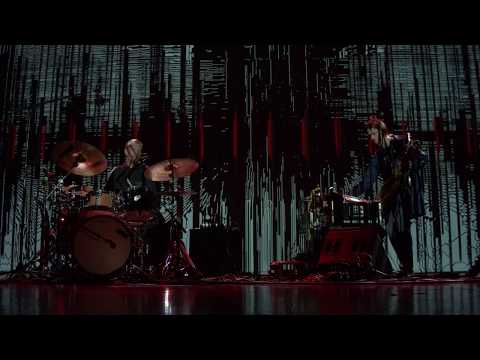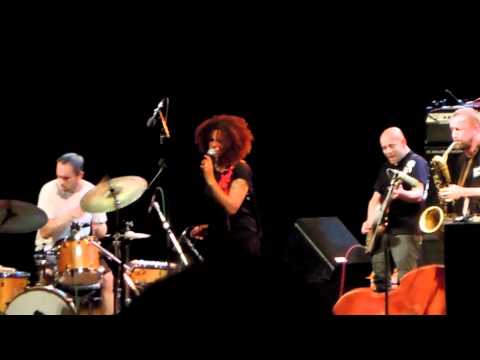Ljubljana Jazz Festival
Past events
-
26 Sep 2015
HungaryBudapestBudapest Music CentreFollow the white rabbit, a lecture by Bogdan Benigar, director of the Ljubljana Jazz Festival, at the European Jazz Conference
Programme
In keeping with the contemporary adage that jazz is about how you play rather than what you play, the festival's programme ranges widely across all forms of jazz expression, from hard, exploratory improvisation, through the recent adoption of found sounds and electronics, to funkier and more soulful styles. The international dimensions of the festival are well-established, with perhaps a slightly greater emphasis on European artists than on those from across the Atlantic in recent years.
The festival also features an accompanying programme. Including residency programmes, film screenings, round tables, lectures, poster and jazz photography exhibitions, and multimedia installations. Although the festival is centred on events in late June, Cankarjev dom also stages a year-round programme of events under the festival name, as well as the Tuesday Clubbing (Cankarjevi torki) series, which attempts to keep the festival spirit alive from September to April with an adventurous programme spanning jazz and roots.
Venues
Since 1982 the festival has been held in the concert halls of Cankarjev dom (CD), Slovenia's national cultural centre, with the revitalised CD Club being brought into the fold in 2008 and the CD park (officially the Council of Europe Park) becoming the main venue in the late 2010s. Križanke no longer stages festival events.
Prehistory and early years
The seeds of the festival that formally emerged in 1960 as the Yugoslavian Jazz Festival were sown in the years following the end of World War II and the formation of the RTV Slovenia Big Band. Jazz was incorporated into the band's programme for a few years before being declared politically undesirable, but managed to resurface in the second half of the 1950s. In the meantime, the various Yugoslavian pop festivals had helped create a lively, interconnected music scene that meant that the first edition of the jazz festival edition had an extensive, ready-made line-up featuring musicians from all parts of the federal republic. Correspondingly, the Slovenian pop music festival Slovenska popevka, established in 1962, shared most of the Slovenian musicians who appeared at the jazz festival.
For the first six years, the festival took place in Bled, before moving to Ljubljana in 1967. Three years later, it installed itself in what would become its home for many years: the Križanke complex in the city centre. For the first two decades or so, the festival was organised by Jazz Society Ljubljana, and its close ties with the RTV Slovenia Big Band, then a bastion of Slovenian jazz traditionalism, meant that the programming remained broadly conventional and, to some extent, conservative. The festival featured more or less exclusively Yugoslav musicians and Yugoslav radio big band ensembles, although there were notable exceptions, such as the Albert Mangelsdorff Quintet (1962), the Modern Jazz Quartet (1964), the Krzysztof Komeda Quintet (1965), Jean-Luc Ponty (1967) and Memphis Slim (1968).
1970s
The 1970s brought a loosening of the unspoken strictures that had applied in the festival's first decade, with free jazz, fusion and "ECM jazz" gaining admittance (if not full acceptance). The international dimensions of the festival also expanded, with some of the biggest names of the decade appearing in Ljubljana: Bobby Hutcherson and Harold Land in 1971, the Bill Evans Trio and Ram Chandra Mistry in 1972, the Archie Shepp Quintet in 1973, the Jazz Messengers, the Stan Getz Quartet and Odetta in 1974, the Elvin Jones Quartet in 1975, the Cecil Taylor Quintet in 1976, Paul Bley in 1979 and the Pharoah Sanders Quartet in 1981.
1980s
In 1982, organisation of the Ljubljana Jazz Festival passed from Jazz Society Ljubljana to the newly opened Cankarjev dom national cultural centre. This heralded the establishment of a new curatorial model, with the enlarged programming panel seeking to open the festival up more fully towards new jazz and new improvised forms. While this met with some resistance and a fair amount of public polemic, it was well received by a younger audience keen to move on from the older sounds. The first signs that things were changing came with the appearance of the Sun Ra Arkestra in 1982, followed by other figures from the left field of jazz: Steve Lacy and Mal Waldron, Irene Schweizer, the Lester Bowie Ensemble, and the Keith Tippett-Peter Brötzmann Quartet.
Internal squabbles continued, which led to that portion of the programme panel agitating for further reform, and for the inclusion of other (experimental) genres of music, establishing the Druga Godba Festival in 1985. The festival nevertheless managed to maintain a strong programme through the 1980s, with appearance from the likes of the Vienna Art Orchestra, Anthony Braxton Quartet, the Trevor Watts Trio, the Julius Hemphill Jah Band, Dudu Pukwana and Zila, the McCoy Tyner Trio, the Art Ensemble of Chicago, Max Roach, Roscoe Mitchell and Gilberto Gil.
1990s and the 21st century
By now a well-established stop for some of the world's top jazz musicians, the festival played host in the 1990s and early 2000s to artists such as Steve Coleman's Five Elements, Miles Davis, the Don Byron Klezmer Orchestra, the Bill Frisell Group, Defunkt, Marc Ribot, the Peter Brötzmann Chicago Tentet, Femi Anikulapo-Kuti and the Positive Force, the Jan Garbarek Group, the Ornette Coleman Quartet, Abdullah Ibrahim, the Wayne Shorter Quartet, Reggie Workman, Charlie Haden Quartet West and Kenny Garrett.
After celebrating its 50th birthday in 2009, the festival continued to present strong programmes comprised of established artists, emerging talents and special projects: Han Bennink, Avishai Cohen, Hamilton de Holanda, Richard Galliano, John Zorn (with various projects), Peter Brötzmann (who was the subject of a four-concert special focus in 2013), Maria João, John Scofield, Neneh Cherry (with The Thing), David Murray, Macy Gray, Sly and Robbie with Nils Petter Molvær, Mercedes Sosa, Gregory Porter, the Vijay Iyer Trio, Peter Evans, Nate Wooley, Dans Dans and Fire! Orchestra.
2016 onwards
Starting in 2016, the festival took another of its frequent left turns, moving part of the programme into the CD park for a series of free daytime and early evening concerts. The park programme has since been extended in volume and scope to become an established part of the festival, in keeping with the stated aim of creating a "jazz community" and of attracting new audiences perhaps less inclined to take a punt on performances in the more formal indoor settings of the cultural centre. The move paid off handsomely in 2020, when the relaxed outdoor character of the festival, a mixture of live performances and big-screen streaming, made it one of the most joyous events to take place in the capital during the brief Covid-19 summer hiatus.
The renewed emphasis on providing a platform for Slovenian acts, in place from 2017 or so, is a further element of the festival's attempt to build a jazz community, as well as to capitalise on what is something of a homegrown "golden generation": Jure Pukl, Marko Črnčec, Igor Lumpert, Žiga Murko and Žan Tetičkovič in New York, Dré Hočevar and Kaja Draksler in Amsterdam, and Jani Moder, Kristijan Kranjčan, Cene Resnik, Igor Matković, Samo Šalamon and Boštjan Simon in Ljubljana. All have played the festival, solo or in various formations, since 2015. The 2019 and 2020 editions featured the Alphabet and Young Explorers series of concerts, which was curated by Dré Hočevar and showcased some of the young musicians clustered around the .abeceda Institute.
However, as the festival's seventh decade gathers pace, the space remains very much open to new (and older) international avant-garde sounds in jazz and beyond: James Blood Ulmer, Evan Parker, Mats Gustafsson, Ken Vandermark, the Yussef Dayes Trio, Archie Shepp, Emilia Martensson, Shabaka Hutchings, Nasheet Waits, Hamid Drake, Paal Nilssen-Love and Moor Mother, to name only a few. While the new outdoor focus of the festival has led to a more intimate atmosphere, use continues to be made of CD's indoor venues for marquee events: Gallus Hall in Cankarjev dom for the mammoth John Zorn Bagatelles Marathon in 2019, for example. In that same year, Križanke was also used for the first time since 2013 for a performance by US multi-genre ensemble Snarky Puppy.
Directors and curators
Bogdan Benigar became the festival director in 1999, working under artistic directors Oliver Belopeta (Skopje Jazz Festival, 2000–2004) and David Braun (2005–2008) before taking sole custody of the programme for two editions. He was then joined as co-curator by Pedro Costa (2011–2017) and Edin Zubčević (Jazz Fest Sarajevo 2018–).
Costa's involvement also resulted in the ongoing Ljubljana Jazz Series of live recordings, released by Clean Feed Records of Lisbon, one of Europe's most daring improvised music labels, and home to quite a number of Slovenia's younger jazz generation. Eleven records have been released so far, with more expected. This follows on from a well-established festival tradition of live recording that stretches back 50 years and includes Cecil Taylor's legendary Dark to Themselves album.
See also
- Cankarjev dom, Music Programme
- Križanke
- RTV Slovenia Big Band
- Festival of Slovenian Jazz
- Druga Godba Festival
External links
- Festival website
- Festival, Facebook
- History of the festival, with full list of performers up to 2009 (in Slovenian)
- Ljubljana Jazz Festival tag, All About Jazz magazine
- Preview of the 2020 festival, Kongres magazine, June 2019
- 2018 EJN Award announcement, 2018
- Short profile of Bogdan Benigar, Jazz Connective
- List of festival live recordings, Discogs

